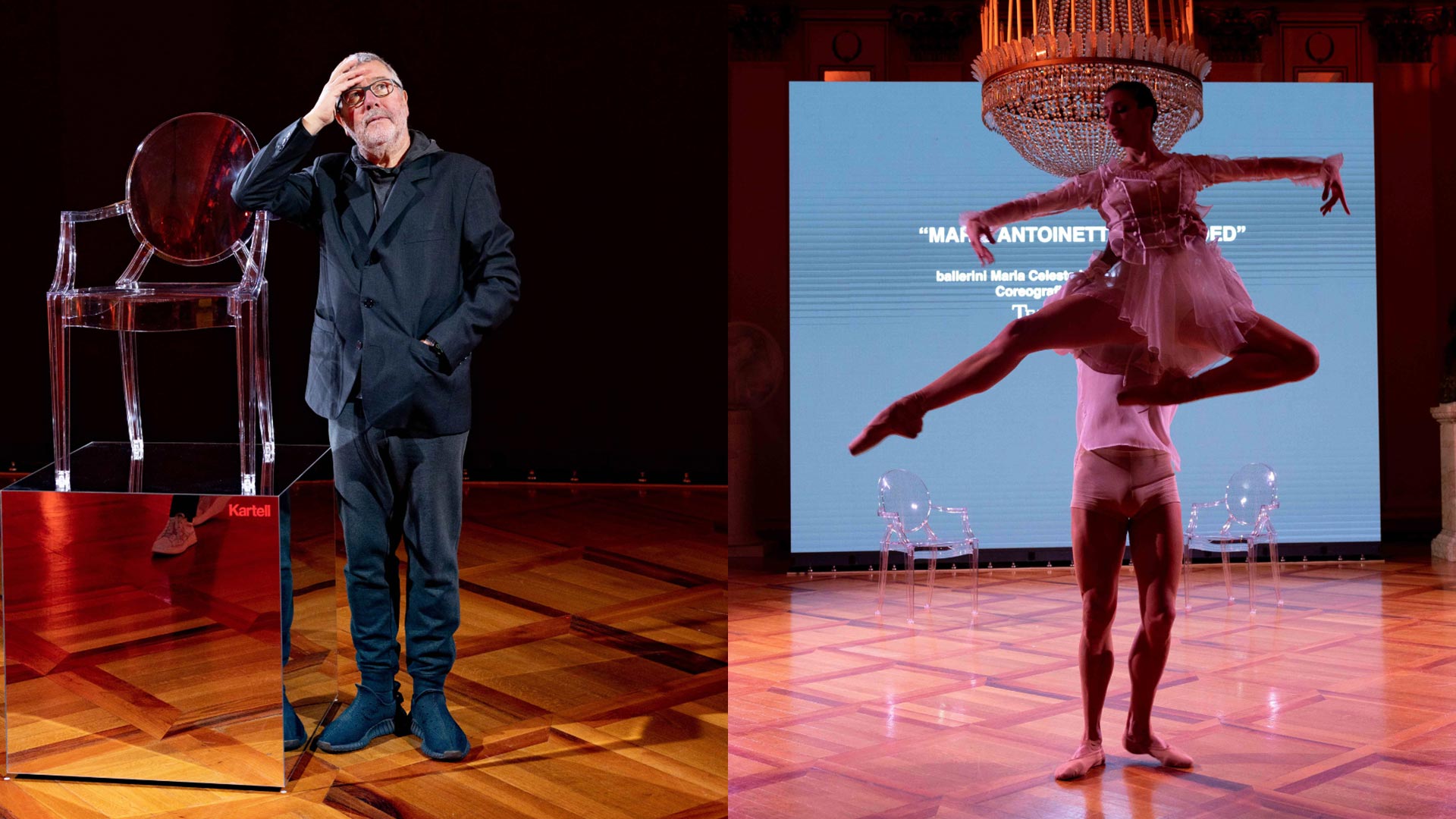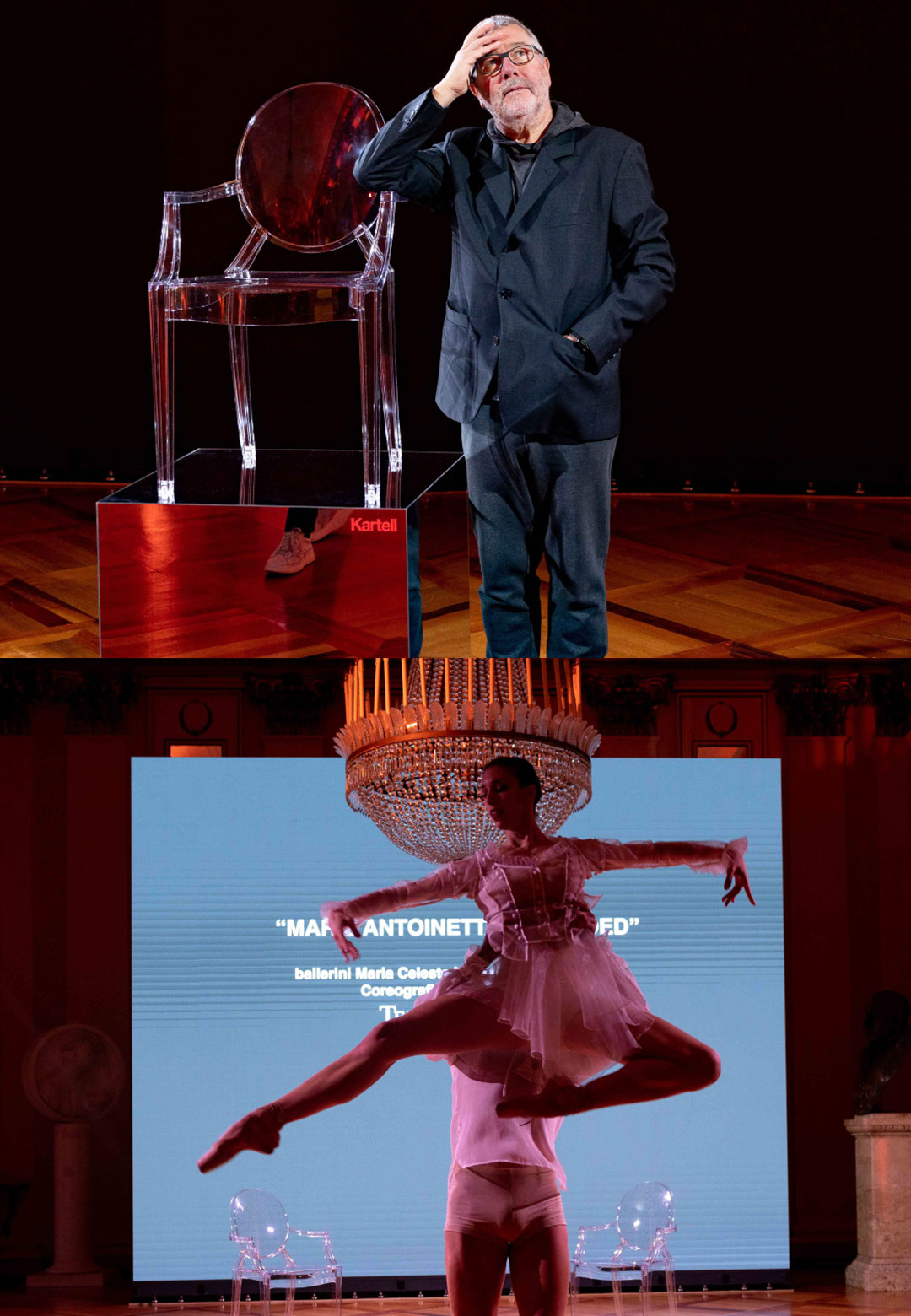Brought together by a mutual quest of abstracting arresting sceneries and inspiring concepts into art, performance, and design, four collaborators with distinct stylistic identity and from various locations, recently came together—in spirit and form—to celebrate the 20th anniversary of Louis Ghost, a contemporary reinterpretation of the famous Louis XV chair by French designer Philippe Starck. Louis Ghost, designed by Starck for the Italian furniture brand Kartell, is a transparent chair that subverted the norms of style and materiality when it was initially launched in 2002. Following this route of challenging archetypal trends, Kartell collaborated with the Milanese opera house Teatro alla Scala to design an ode—with dance and music—to the chair that turns 20 this year.
The ballet performance—choreographed by Patrick de Bana and performed by La Scala soloist dancers Maria Celeste Losa and Gabriele Corrado, along with Louis Ghost—was titled Marie Antoinette Reloaded. It served as the culmination of various stories, namely Starck’s Louis Ghost, created for Kartell; Patrick de Bana’s fascination with Louis XVI’s consort and queen of France, Marie Antoinette; and the 18th-century Louis XV armchair—better known as Marie Antoinette's chair, designed by Jean-Baptiste-Claude Sené—that inspired the creation of Louis Ghost. The performance is inspired by the pas de deux Marie Antoinette, produced and performed by Patrick de Bana in 2010.
“What I’m most interested in as a choreographer and author is that which is invisible, which we cannot see, because I think that is where the truth lies. Everything that surrounds us is just an illusion. I decided to use Kartell chairs; when I saw them, they looked like chairs but they aren’t really chairs. Like I said, it’s an illusion…I can sit down and feel like I’m seated on the French throne; if I really believe it, it is so,” says Patrick de Bana. Marie Antoinette Reloaded was designed to encapsulate the qualities of elegance, style, and lightness, just like Louis Ghost, hence serving as a perfect tribute to the iconic chair. Johann Sebastian Bach’s Goldberg Variations further enveloped and enhanced the performance with its ethereal piano notes.
The clean lines of the chair first caught the choreographer’s eye and imagination in 2010, inspiring the production of Marie Antoinette. Building on Marie Antoinette’s choreography, de Bana designed an original performance to honour the completion of two decades of Louis Ghost. “The context is different every time. When I was asked to work on this project, I took some moments from the original production, and then adapted them to this new version created especially for Kartell. I chose this sequence, which comes right at the end of the ballet. It’s like we’re showing the last five minutes of a film, there’s a whole story that precedes it, a whole life. That’s why I tried to create this new version by paring it down to make it impalpable, abstract; it could be a wedding pas de deux, a coda, a farewell pas de deux, so that the audience has scope to dream and think,” says de Bana.
The ballet performance and Louis Ghost are also part of the short film Louis Ghost on Stage, directed by film director Aksinja Bellone. “When I met the choreographer Patrick de Bana, he explained that his aim was to channel the spirit of Marie Antoinette: he imagines her being accompanied by her king, never abandoned, even in the darkest moments of solitude leading to the gallows that awaited her. The idea of combining Design and Dance was something that had always appealed to me and this was the perfect opportunity. The Louis Ghost is a symbol, an allusion to the throne about to be lost, and to a spirit that wants to live forever. It makes way for the concept of the spirit living a human experience, and not vice versa, hence the concept of being eternal,” Aksinja Bellone says. Bellone looks at the chair as a symbol of something that is ostensibly lost, yet lives on, reminding us that we are never left alone.
Louis Ghost was initially created using a transparent but incredibly durable material sourced from a multinational chemical company, and until then used only to build American police shields and functional products. A later iteration of the chair was made by injecting polycarbonate in granular form into an industrial mould. The chair design expertly combines the form of the traditional Louis XVI armchair and the novel innovations offered by postmodern technologies. A sturdy piece with a medallion backrest, it includes a little Kartell emblem in translucent red ink on its back as a mark of authenticity.
“Twenty years ago, producing a transparent chair, THE transparent chair, meant subverting stylistic canons to create a product with a very strong identity that was instantly recognisable and unmistakable, but that at the same time was able to adapt to any setting and all tastes. The chair emerged from the dialogue between Kartell and Philippe: a timeless object whose characteristic identity is founded on beauty and quality,” shares Claudio Luti, CEO of Kartell.
Today, Kartell's technological innovation has enabled the manufacturing of Louis Ghost in new green polycarbonate, primarily made from paper and industrial cellulose waste. Since the paper is ISCC-certified (International Sustainability and Carbon Certification), the environmental impact in terms of carbon dioxide emissions are minimised by up to 60 per cent.
Philippe Starck says, “20 years ago, the Louis Ghost chair designed itself, produced by our collective western subconscious. Visible and invisible, real and immaterial, elegant and intelligent. As a natural result of our past, our present and our future, Louis Ghost continues its evolution in polycarbonate 2.0 patented by Kartell. The same good design as always, the most advanced technology and the minimum amount of material, strictly sustainable, all at a fair price. Louis Ghost is democratic design 2.0.”
Starck designed the chair after gleaning information and inspiration from various traditional and contemporary sources. The result is a chair that continues to remain iconic—with its revolutionary style, atypical design and materiality, and technological adeptness—even after two decades. Over three million pieces of the chair have been manufactured since 2002, demonstrating its timelessness. Although designed as a product meant for mass production, Louis Ghost has managed to inscribe snippets and tales across various locations, just like the stories that inspired its creation.
Louis Ghost has established itself in front of the world's greatest wonders, both natural and man-made. From Venice to Greece, Tokyo to Rio de Janeiro, London to Paris, and the Great Wall of China to the Cape Town cliffs, the iconic chair has travelled and experienced various cultures and societies. It has interacted with the likes of Pope Benedict XVI and Her Majesty Queen Elizabeth II.
In the last two decades, the chair has been dressed, painted, sculpted, scaled down, and interpreted by artists, stylists, and designers worldwide. While New Zealand-based artist George Tamihana Nuku inscribed Maori art on the chair, students from the Brera Academy painted it in multiple colours, and Italian fashion brand Antonio Marras gave it wings. Piero Lissoni lit up the edges of the chair in neon, Bob Wilson doodled on its surface with poetry, and Philippe Starck picked it up once again to cover it with the street map of Milan. Through these changes and interpretations, Louis Ghost has remained alive in its original spirit and character.
The latest experiment with Louis Ghost, too, ensures the retention of the chair’s original essence and spirit. The Toscanini Foyer of the Teatro alla Scala presents an exposition of pictures and videos delineating Louis Ghost’s journey across time and locations, as well as the chair’s monologue in actress Matilde Giol’s voice, which begins with, ‘I am Louis Ghost. I’m a chair and I am twenty years old,” and continues to narrate its story, in Lidia Labianca’s words.






 Sign in with email
Sign in with email










What do you think?